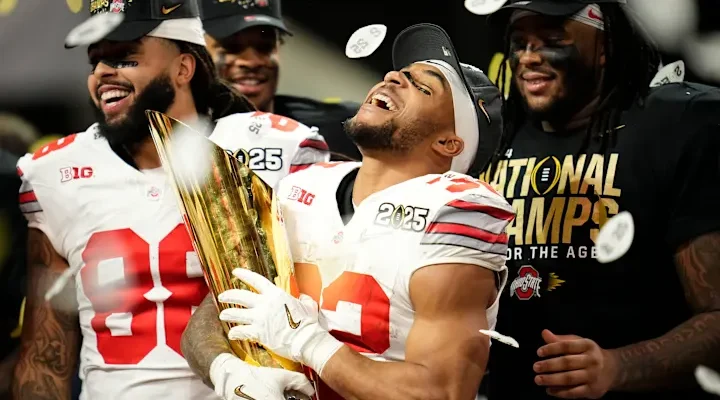Why Ohio State Football Remains the Most Recession-Proof Program in College Football Despite Shifting Landscapes, Rising Costs, and Changing Competitive Dynamics
In the unpredictable world of college football, where economic challenges, shifting conference alignments, NIL negotiations, and transfer portal chaos have altered the way programs operate, very few schools can claim immunity from instability. Yet, Ohio State stands as a model of resilience—arguably the most recession-proof program in the sport. Whether in recruiting, revenue generation, fan engagement, or competitive consistency, the Buckeyes have built a foundation that can weather nearly any storm, both on and off the field.
One of the primary reasons for Ohio State’s remarkable stability lies in its brand power. The scarlet and gray are more than just colors—they’re symbols of tradition, winning, and national relevance. For decades, the Buckeyes have been among the most recognizable names in all of sports, not just college football. That recognition transcends regional boundaries. Even in years when the team doesn’t win a national championship, their games attract massive TV audiences, merchandise sales remain strong, and recruits from across the country dream of playing in Columbus. This unwavering brand loyalty ensures Ohio State remains financially and competitively stable even in turbulent times.
The program’s revenue streams are equally impressive and reliable. Ohio State’s athletic department generates some of the highest revenue figures in the NCAA, thanks in large part to sold-out home games at Ohio Stadium, lucrative media rights deals, and a national fanbase that spans far beyond Ohio’s borders. Ticket sales rarely slump, even in seasons with a loss or two, because Buckeye Nation turns game days into statewide events. Corporate sponsorships, alumni donations, and premium seating packages further bolster the budget, allowing Ohio State to invest heavily in facilities, coaching salaries, and player resources. That kind of financial muscle keeps the Buckeyes competitive regardless of broader economic downturns.
Recruiting is another pillar of Ohio State’s recession-proof status. Under head coaches like Jim Tressel, Urban Meyer, and now Ryan Day, the Buckeyes have consistently brought in top-five or top-ten recruiting classes. Even in years when national powers like Alabama or Georgia dominate headlines, Ohio State remains a recruiting juggernaut. Their appeal is simple: a clear path to the NFL, the chance to play in front of 100,000 passionate fans every week, and the prestige of joining a program that has been in the national conversation for generations. NIL opportunities have only enhanced that appeal, as Columbus and the Ohio State brand provide players with some of the most lucrative endorsement potential in the country.
On-field consistency also makes the Buckeyes recession-proof. The program has not endured a true losing season in decades. They dominate the Big Ten year after year, regularly contend for the College Football Playoff, and develop NFL talent at a staggering rate. Even in transitional years, when other programs might struggle, Ohio State rarely dips below double-digit wins. This track record creates a self-sustaining cycle—top players want to come to Columbus because they know they’ll compete for championships, and that constant influx of talent ensures the wins keep coming.
The fan culture at Ohio State is another irreplaceable asset. Buckeye Nation is not just loyal; it’s generational. Families pass down their passion for the team like an inheritance, and the game day experience in Columbus is unlike any other in the sport. Whether the economy is thriving or struggling, fans still fill “The Horseshoe” and travel in huge numbers to away games and bowl matchups. That unwavering support creates a financial and emotional safety net that few programs in the country can match.
Furthermore, Ohio State has adapted quickly to the changing landscape of college football. The rise of NIL, the transfer portal, and conference realignment have destabilized many programs, but Ohio State’s infrastructure and leadership have kept them ahead of the curve. They’ve embraced NIL without compromising the team culture, leveraged the transfer portal for strategic roster additions, and positioned themselves as a major player in the Big Ten’s evolution into a coast-to-coast conference. The Buckeyes have the resources, connections, and foresight to thrive no matter how the sport’s rules evolve.
There’s also a sense of institutional stability that strengthens Ohio State’s foundation. The athletic department’s leadership, alumni involvement, and deep-pocketed donors provide a level of governance and financial backing that ensures the football program remains a top priority. Facilities are constantly upgraded, nutrition and strength programs are cutting-edge, and player support services—from academics to mental health—are among the best in the country. This holistic investment in the program ensures it remains an attractive destination for both players and coaches.
Even when Ohio State faces challenges—such as heartbreaking losses to rivals or playoff disappointments—the program never experiences the kind of prolonged slump that derails other schools. Their resilience is a result of preparation, resources, and a clear identity. They know who they are: a blue-blood program that expects to win every Saturday, regardless of opponent or circumstance.
In the modern era of college football, where instability has become the norm, Ohio State’s ability to maintain its dominance is no accident. It’s the result of decades of strategic growth, an unmatched fan culture, elite recruiting, and a brand so strong that it withstands any external pressure. The Buckeyes don’t just survive changes in the sport—they adapt, thrive, and set the standard for what a stable powerhouse looks like.
Ohio State may not win the national championship every season, but their position as the most recession-proof program in college football is undeniable. They are built to weather challenges, seize opportunities, and keep winning, no matter how the winds of change blow through the sport. That’s not just impressive—it’s the blueprint every other program wishes they could copy.



